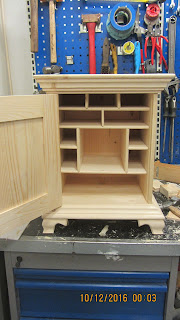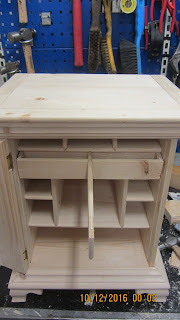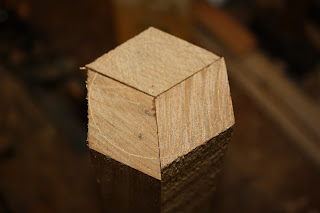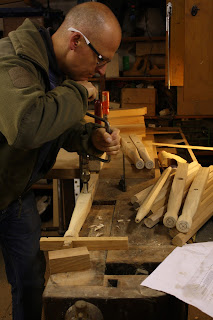After one week of a shop that feels a lot emptier and quieter, I have gathered some thoughts about the DCBE this year.
I am able to fit 5 people in my workshop, but in order to do so, I need to borrow yet another workbench from Olav, or I could make an extra one myself.
This time we had three workbenches for four people, but since there was always someone busy at the lathe it was fine that way.
We spent a lot more time than anticipated doing noisy stock preparation, but that was mostly due to our very ambitious goals of making a lot of chairs.
Once the turning had also stopped, the workshop was fairly quiet save for the pounding on the copper rivets.
Compared to the last DCBE, where we made Welsh stick chairs, there was a lot more machine work involved this time. But I think the results are well worth it.
We skipped lunch some days, but the daily intake of cake and tea or coffee plus beer made up for that. Having the supper supplied by a catering company was a great success. It meant that there was one thing less to concentrate on, and instead of making supper, Mette baked rolls for breakfast every day, and kept a steady supply of cakes coming our way.
Hosting an event like this is no trouble at all with such nice attendees. Pedder and Brian brought beer and Alex brought some softdrinks called Almdudler that our kids really liked,
Asger proclaimed at the end of the DCBE, that he had not been sick since he started drinking Almdudler. When we said that he had just had them for 6 days, he quickly responded that he knew that, and he had felt great all those days, so he suggested that we should continue like that. But we are back to drinking milk again for the everyday meals, and the soft drinks are reserved for Friday evening.
Everyone also had some gifts for me, and something for Mette as well, so I feel almost ashamed that I could only supply a meagre selection of wood and some beds to sleep in.
Alex and Pedder brought some nice homemade marmalade and a type of pickles, wine and some syrup.
For me, Alex brought the most beautiful set of dowel plates that I have ever seen. They are made especially for him by the company
BLUM in his hometown that produces hinges and other sort of brackets.
The company has their own training department for machinists, and they made a small production run of those dowel plates. Each plate is precision milled with a sharp entry side and tapering exit side of the holes for the dowels. The plates are 2.25" x 10" and a bit over ½" thick. I guess they are made out of tool steel.
These two plates cover the hole sizes from 11 mm to 20 mm in diameter (7/16" - 13/16")
Alex told me that the company will also make a plate with holes ranging from 6 to 10 mm, but they hadn't made it yet.
Given that I really like timberframing, a dowel plate with such large holes is really useful for me.
I think that I might make a recess in my workbench for them, and then I just need to make a bunch of dowels.
Pedder gave me an absolutely magnificent dovetail saw.
The saws from
Two Lawyers Tools don't just look good. They are incredible to use as well.
Mine has a rosewood handle and a heavy brass back. There is a very slight hang of the saw, and the saw feels just like an extension of my arm. I have used it for cutting some small dovetails in the drawers for the travelling bookcases, and it is just perfect. I can highly recommend their saws if you find yourself in the market for a custom made backsaw.
Brian had brought some old turning gouges and a new blade for my Ryoba saw.
So all in all it felt a lot like Christmas eve to me.
If you are considering organising an event like this, I suggest that you do it. It is a special experience to work together in a smallish shop, and learn from each other as you go along. This time we had the benefit of Brian actually being an expert in Roorkees, having made quite a few of them, but when we made the Welsh stick chairs, none of us had tried it before, That too was a fun experience.
My best advice is to have some of the food organised, and it is better to start with a small group of people, and then perhaps invite more if you find there is room for it.
Thanks to everyone reading and commenting on the posts from Danish Chairbuilding Extracaganza 2016 on this blog and on
Toolerable and on
Old Ladies.
I better start thinking about what to build for DCBE 2018.
The best looking dowel plates I have ever seen!
These plates from BLUM are amazing.
My new Sunday saw from Two Lawyers Tools.
A bit of progress on the travelling bookcases. Lining the drawers with felt.





















































